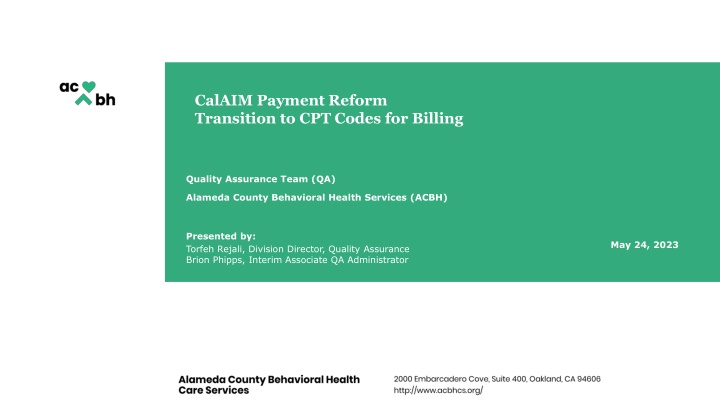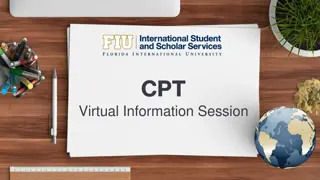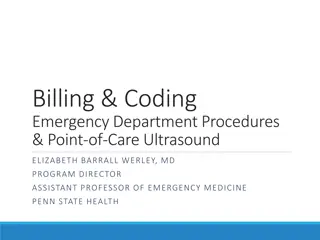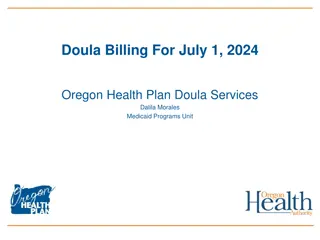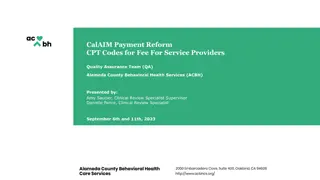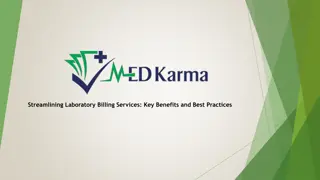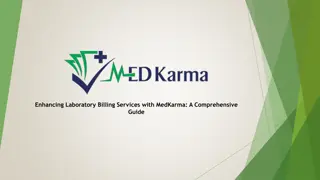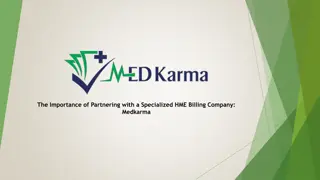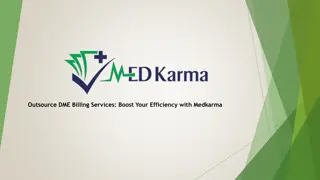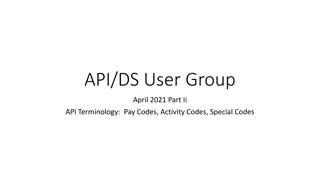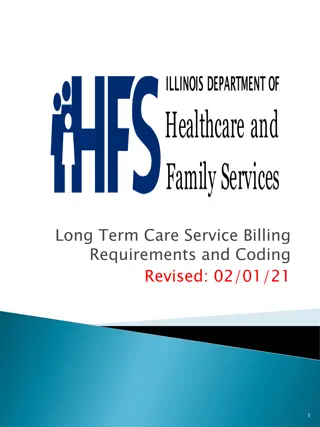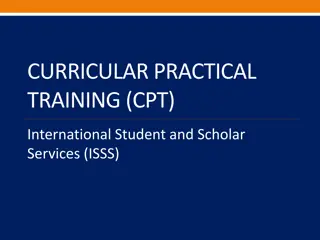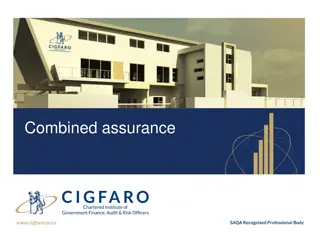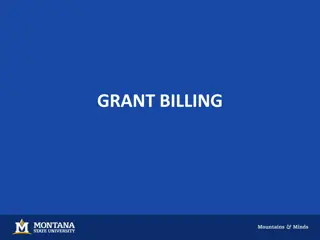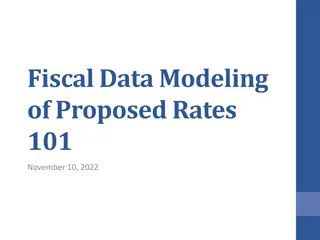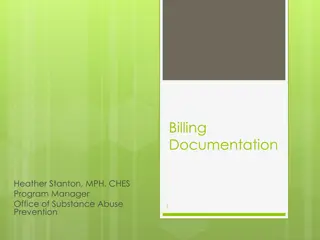CalAIM Payment Reform Transition to CPT Codes for Billing Quality Assurance Team
The CalAIM Payment Reform initiative starting July 1, 2023, entails changes in reimbursement structures, financing mechanisms, and provider billing methods for county BH plans, with a transition to CPT coding and SmartCare system. Service entry requirements for legacy systems and SmartCare are outlined for effective billing and claims management. Providers are advised on timelines and procedures for adapting to the new payment reform measures.
Download Presentation

Please find below an Image/Link to download the presentation.
The content on the website is provided AS IS for your information and personal use only. It may not be sold, licensed, or shared on other websites without obtaining consent from the author.If you encounter any issues during the download, it is possible that the publisher has removed the file from their server.
You are allowed to download the files provided on this website for personal or commercial use, subject to the condition that they are used lawfully. All files are the property of their respective owners.
The content on the website is provided AS IS for your information and personal use only. It may not be sold, licensed, or shared on other websites without obtaining consent from the author.
E N D
Presentation Transcript
CalAIM Payment Reform Transition to CPT Codes for Billing Quality Assurance Team (QA) Alameda County Behavioral Health Services (ACBH) Presented by: Torfeh Rejali, Division Director, Quality Assurance Brion Phipps, Interim Associate QA Administrator May 24, 2023
CalAIM Payment Reform Initiative and Timelines Timing of Service Entry into SmartCare and Clinician s Gateway Provider Billing What Is Changing Billing Rules for Interns and Students CPT Code Key Concepts: Resources Procedure Codes, Units, Dependent-On Codes, Modifiers, Lockouts Reimbursement for Documentation and Travel Time SmartCare Automation and Functionality Clarification of Specific Services/Frequently Asked Questions Review of Reference Guides Q&A Topics 2
CalAIM Payment Reform Initiative and Timelines Beginning July 1, 2023, the CalAIM Behavioral Health Payment Reform initiative will change the way county BH plans claim federal and state reimbursement. The initiative consists of three different transitions: Reimbursement Structure: End cost-based reimbursement and implement fee-for-service payments to county BH plans. DHCS is changing reimbursement structure to Counties effective July 1, 2023. ACBH is changing reimbursement structure to contracted providers in phases beginning FY 23/24. Financing Mechanism: Enable county BH plans to continue providing the non-federal share of cost for Medi-Cal services without certified public expenditures and cost-based reimbursement. Provider Billing: Implement CPT Coding Transition. Also on July 1, 2023, ACBH will be transitioning from its existing billing systems, InSyst and eCura to SmartCare. 3
Service Entry into Legacy Systems for Dates of Service Through June 30, 2023 All services with dates of service June 30th and earlier must be entered into the legacy systems (InSyst, eCura, legacy Clinician s Gateway) by July 21, 2023. Providers are encouraged to enter the majority of their services provided through June 30, 2023 into these systems before the July 1, 2023 SmartCare launch. After July 1, 2023, there will be two CG environments for each system of care (2 for MH and 2 for SUD). The legacy CG systems will feed information for services dated prior to 7/1/23 to InSyst. 4
Service Entry into SmartCare Effective July 1, 2023, the new CG systems will automatically upload information to SmartCare. Providers not using CG will need to enter their services into SmartCare. Providers will have until September 15, 2023 to enter all their July and August services into SmartCare. Although permissible, please note that waiting to enter the services will delay submission of your invoice for July and August claims. 5
Provider Billing What is Changing Changes to procedure codes: Addition of CPT codes to both SMHS and DMC-ODS delivery systems. More codes with more specific usage. Most CPT codes may only be used by licensed/registered/waivered professionals. HCPCs will continue to be used by both licensed and non-licensed staff and for Existing Day/24-hour services. Duplicate Service Changes Modifier Changes Significant expansion of code lockouts 6
Provider Billing Payment Reform does not change definitions of MH or SUD services. Definitions of services for each delivery system can be found in the DHCS Billing Manuals. Providers may only claim SMHS and DMC-ODS for the defined services in each delivery system and choose the best code to describe the services provided in accordance with their ACBH contract deliverables and Medi-Cal certification. ACBH has provided a Preliminary list of codes that will be available in SmartCare. Providers will still be able to claim for non-MediCal billable services, per their contract [e.g. Outreach (Mode 45), Supportive services (Mode 60), MAA (Mode 55), ACBH special non-billable codes, etc.]. ACBH plans to retain the same procedure code numbers that were used in InSyst for these codes. Note: Providers will continue to use County defined Location Codes in SmartCare. 7
What codes do Interns use to bill for services? Interns are registered, pre-licensed mental health professionals who work in clinical settings under supervision (e.g., ASW, AMFT, APCCs, etc.). In both Specialty Mental Health (SMHS) and Drug MediCal Organized Delivery (DMC- ODS) systems, Interns should use the Taxonomy codes for the profession for which they are registered. Interns may use CPT codes and HCPCs to bill. SmartCare will automatically attach the HL modifier to their claims to identify them as an intern. 8
What codes do MH students use for billing? MH students are individuals not registered with the appropriate board SMHS DMC-ODS MH students should use Taxonomy codes for MHRS, Other Qualified Professional, or Certified Peer Specialist, based on their education, training, and experience. Per Assembly Bill 1860 & BHIN 23-008 graduate students may provide services in DMC-ODS. The latest version of the DHCS DMC-ODS billing manual does not include information about students performing services in DMC-ODS. Cannot use CPT codes to bill Can use HCPCs, depending on their designation: H0031 MH assessment by non-physician H0032 MH service plan by non-physician H2017 Psychosocial rehabilitation H2021 Community wrap-around services H2000 Comprehensive multi-disciplinary eval. T1017 Targeted case management H2011 Crisis intervention We are expecting additional information from DHCS on this matter when the next version of the SUD billing manual is issued. 9
CPT Code Basics: Reference Guides and Resources Procedure Code Descriptions Reimbursement of Documentation and Travel Time Entering Services in SmartCare 10
Reference Guides and Resources American Medical Association (AMA) CPT Codebook AMA/CPT site Short Doyle Medi-Cal References CALAIM References and Manuals Effective 7/1/23: CalAIM Reference Guide for CPT Codes -Specialty Mental Health CalAIM Reference Guide for CPT Codes - Drug Medi-Cal Organized Delivery System Short Doyle Medi-Cal Manuals CALAIM References and Manuals Effective 7/1/23: Specialty Mental Health Billing Manual Drug Medi-Cal ODS Billing Manual ACBH Reference Guides on QA Training webpage Detailed Preliminary DMC-ODS Codes in SmartCare Detailed Preliminary SMHS CPT Codes in SmartCare SmartCare Billing System Implementation and Payment Reform FAQ Section 19 of the QA Manual CalMHSA Payment Reform webinars CPT Code 101- Introduction to CPT Codes CPT Code 102- Optimization of CPT Codes for Majority of Behavioral Health Services Note: Department of Health Care Services expects providers to be familiar with and follow the rules noted in the CPT Code Manual 11
A Word About This Training This training is not intended to be a full training on Current Procedural Terminology (CPT) coding but is an introduction to key concepts. ACBH will continue to provide trainings, technical assistance, and build controls into our systems. Providers are encouraged to seek out external resources and trainings as necessary to ensure compliance with rules for the codes they claim. ACBH and other oversight entities (e.g., DHCS, CMS, OIG, etc.) will hold providers to CPT/HCPC standards, regardless of ACBH training. ACBH strongly encourages providers to closely review DHCS billing manuals and updates as well as follow guidance in the American Medical Association's (AMA) CPT Codebook. 12
SmartCare Automation and Functionality Starting 7/1/23, SmartCare will have functionality to prevent some service entry errors. SmartCare will: Prevent services entry for dates of services before 7/1/23 . Only allow staff with the correct disciplines to use certain codes. Prevent codes from being used when the service time exceeds what is allowed for the code. Calculate the Units based on Service Duration minutes and CPT Procedure Code. SmartCare will not: Prompt users to add Dependent-On codes. Prevent codes that are locked out. Lockout edits may be a future SmartCare design. 13
Procedure Code Descriptions Most Procedure Code descriptions provide the time or time range associated with the service. For those that do not, DHCS has assigned a time of 15 minutes. A service associated with multiple time ranges, is shown in SmartCare as one bundled Procedure Code (see example). SmartCare will choose the specific Procedure Code based on the Face-to-Face time entered by provider. In this example, SmartCare will show this: 99202-99205 Office or Other Outpatient Visit of New Patient, 15-74 Minutes 14
Time Associated with Procedure Codes Per DHCS, providers must be familiar with and follow the rules noted in the CPT Code Manual. Some services can be claimed once they reach the mid point of the time associated with code. For example, Targeted Case Management has a 15-minute time associated with the code. The service cannot be claimed unless it lasts at least 8 minutes (midpoint). Other codes, have a time range associated with the service and the service can be claimed as long as it fits within the designated time range. For example, code 99202 is claimed for services that last anywhere from 15-29 minutes. NOTE: Snapshots of the Procedure Code tables used throughout the presentation only show a piece of the section for demonstration purposes. 15
Direct Patient Care Example of codes that can be claimed without the patient present In general, for most CPT codes*, only the time it takes to provide direct services associated with a code can be claimed to the State. Code 99339- 99340 System DMC-ODS Description Individual physician supervisory of a patient (patient not present) in home. Depending on the CPT code, Direct Patient Care means time spent with: 90846 DMC-ODS Family Psychotherapy (Without the Patient Present) 99367 DMC-ODS and SMHS Medical Team Conference with Interdisciplinary Team of Health Care Professionals, Participation by Physician. Patient and/or Family not present. The patient for the purpose of providing healthcare The consultant/members of the beneficiary s care team (may include family) 99368 DMC-ODS and SMHS Medical Team Conference with Interdisciplinary Team of Health Care Professionals, Participation by Non-Physician. Patient and/or Family Not Present. Direct Patient Care does not include travel time, administrative activities, chart review, documentation, utilization review and quality assurance activities or other activities a provider engages in either before or after a patient visit. H2021 DMC-ODS and SMHS Community-Based Wrap Around Services, per 15 Minutes. (DMC-ODS definition of Code: Coordination of care between providers in the Drug Medi-Cal System and providers who are outside the Drug Medi-Cal System.) *Some E/M codes (e.g. 99202-99205) require including administrative and other tasks into Direct Patient Care time. 16
Reimbursement of Documentation and Travel Time At least through FY23-24, ACBH will continue to reimburse providers separately for travel and documentation time per minute*. PROCESS Providers will: Select CPT codes based on Direct service time only. Enter the following fields in SmartCare and CG: 1) Start Time and Duration for Direct service ( face to face ), 2) Travel time and 3) Documentation time. Receive a monthly report, mimicking the current InSyst invoicing reports, from ACBH for all services (including documentation, travel and face-to-face time) for the previous month. Use the report to bill ACBH for documentation and travel time. *If documentation time is factored into the code, as in the examples provided on the previous slide, do not enter documentation time separately. 17
Entering Entering Services in Services in SmartCare SmartCare In this example, 30 minutes of Face-to-Face, 15 minutes of Travel and 15 minutes of Documentation time was provided. Face-to-Face time refers to Direct Service time. Note that the Total Duration field is 30 minutes. Total Duration equals Direct Service/Face-to-Face time. Providers should select the CPT or HCPC code based on the Direct service/Face-to-Face time. 18
Entering Entering Services in Services in Clinician s Clinician s Gateway Gateway New MH and SUD Service Fields in CG Direct Service/Face-to Face Time 19
Preventing Duplicate Service Errors Except for Interactive Complexity (90785) and Health Behavior Interventions for the Family Without the Patient Present (96170 and 96171), an outpatient procedure is considered a duplicate if all of the following are the same: The beneficiary s CIN Rendering provider NPI Procedure codes/modifiers Date of service If a provider renders the same service to the same beneficiary on the same day in two or more separate encounters, each unique service would be entered separately in SmartCare. The SmartCare system will automatically bundle the services as one service when submitting to Medi-Cal, to prevent duplicate service errors. Providers are encouraged to enter these services timely, so they are bundled on the same claim submission. 20
Dependent On Codes: Add On Codes Supplemental Codes 21
Maximum Units Allowed per Day Outpatient codes have a maximum number of units that can be billed per day. For example, only one unit, or one 15-minute 90791 Psychiatric Diagnostic Evaluation service can be billed per day. Maximum Units are per beneficiary, per service line. For example, if provider A bills for one unit of 90791, provider B can also bill for one unit of the same service on the same day. Add-On codes can be used to extend the time associated with a Service. 22
Combined Aggregate Limits There are some SMHS services that are limited to a specific amount of time in a 24- hour period, according to California Code of Regulations. These include the following: Medication Support Services are limited to 4 hours (9 CCR 1840.372) Crisis Intervention Services are limited to 8 hours (9 CCR 1840.366) Crisis Stabilization Services are limited to 20 hours (9 CCR 1840.368) These are known as Combined Aggregate Limits. The Combined Aggregate is equal to the sum of time associated with all approved services in DHCS claim history provided to the same beneficiary, on the same day. Note: Please see the DHCS SMHS Billing manual for the table list of all the procedure codes and the time associated with each procedure code that SD/MC will use to calculate the combined aggregate. 23
Dependent On Codes Dependent On Codes can only be used in conjunction with another procedure code. These codes cannot be billed unless the provider first bills for the primary procedure to the same beneficiary, on the same date. There are two types of Dependent On Codes: Add on Codes: Add time to a primary procedure Supplemental Codes: Modify a procedure 24
Add On Codes Because of the time associated with Units of Service, some outpatient services may need to be claimed with two procedure codes: the primary code and an add-on code. In the example below, only one 96130 Psych Testing Eval, First Hour can be billed per day. If the psych testing evaluation takes more than an hour, the Add On code of 96131 Psych Testing Eval, Ea Add l Hour would be used to bill for each additional 31-60 minutes of service. Note, 31 is the mid point of the time assigned to this code. SmartCare will show an Error message if the user enters a Total Duration timethat is longer than the code allows.
Add On Codes Some Procedure Codes do not have established Add On Codes. For those services, use G2212 as the Add On Code. This code is used in 15-minute increments and can be claimed once it s midpoint of 8 minutes is reached. Do not use this code if the service already has an established Add On Code. For example, 90791 Psychiatric Diagnostic Eval has a 15-minute time associated with code, and only one service can be claimed per day. Since G2212 has a midpoint of 8 minutes, once the evaluation lasts 23 minutes or more, G2212 can be used to claim for the additional time.
SmartCare Add On Code Example In this example, 60 minutes of Face-to-Face and 10 minutes of documentation and travel time were provided. Primary Procedure Code 90791 Face to Face Time/Direct Service = 60 minutes Total Duration = 15 minutes (due to code limitations) Documentation Time = 10 minutes Travel Time = 10 minutes Add On Code G2212 Total Duration = 45 minutes The Start Time of the primary code automatically populates to the Add-on code. When Add On codes are used, Face to Face Time = Total Direct Service time 27
How do you claim for a multiple family group psychotherapy session that lasts 50 minutes? A. CPT code 90849 for 50 minutes B. CPT code 90847 for 50 minutes C. CPT code 90849 for 15 minutes and G2212 for 35 minutes D. CPT code 90853 for 15 minutes and G2212 for 50 minutes Let s try it 28
Answer How do you claim for a multiple family group psychotherapy session that lasts 50 minutes? A. CPT code 90849 for 50 minutes B. CPT code 90847 for 50 minutes C. CPT code 90849 for 15 minutes and G2212 for 35 minutes D. CPT code 90853 for 15 minutes and G2212 for 50 minutes Primary Code Service Details Primary Procedure Code 90849 90849- Multiple Family Group Psychotherapy- 15 minutes Face to Face Time = 50 minutes Total Duration = 15 minutes (due to code limitations) Add On Code G2212 Total Duration = 35 minutes 29
Supplemental Codes Supplemental Codes describe additional and simultaneous services that were provided to the beneficiary during the visit OR codes that describe the additional severity of the patient s condition. These codes cannot be billed independently and must be submitted on the same claim with a primary code. For example, 90785 is a Supplemental code that can be used to indicate interactive complexity. It must be used on the same claim as one of the primary codes listed in the Dependent On Codes column of the Billing Manual. Supplemental codes cannot be extended with G2212. 30
Lockouts Some codes cannot be billed together, and others can only be billed together in special circumstances. Lockouts apply across the system, not just per provider or per agency. Sometimes lockouts can be overridden with an appropriate modifier. In this example, CPT code 90791 cannot be claimed with 90792 and there are no modifiers that can be used to create an exception, since there is no asterisk on 90792 in the Lockout column. Lockouts that can be overridden are indicated with either one or two asterisks in the lockout column of the ACBH and Short Doyle/Medi-Cal Reference Guides. CPT code 90791 also cannot be claimed with CPT code 90839 and 90840, however, since there is an asterisk on these codes, an appropriate modifier can be used to override this Lockout. Lockout over-riding modifiers only apply to CPT codes, not HCPCS codes. 32
Modifiers Modifiers provide a way to indicate that a service or procedure performed was altered by some specific circumstance but not changed in its definition or code. Modifiers will not impact how much a service is reimbursed but may impact how a service should be billed and/or who pays for the service. SmartCare is being programmed to apply most modifiers automatically or to prompt the user to apply the appropriate modifier. Information will be communicated to providers about this SmartCare functionality, once it becomes available. Examples: Modifier Definition When to Use HQ Group Setting Use this modifier to indicate that a therapy service was provided in a group setting. HL Intern Use this modifier when the service was performed by a registered, pre-licensed MH professional working in a clinical setting under supervision.
Clarification of Specific Service Codes and Frequently Asked Questions 34
How do we claim for group services? Group services can be claimed using specific CPT Codes and if needed, can be extended using G2212 plus the HQ Modifier. Additionally, some SMHS procedure codes (H0034, H2014, and H2017) allow the use of the HQ Modifier to indicate they were group sessions. This option is currently pending a fix from the State. Claims should be submitted separately for each beneficiary receiving group therapy as follows: Enter total face-to-face time on each beneficiary claim. Enter total travel time for the service on one of the client service records OR divide evenly between each participant in the group. Enter individual documentation time for each client separately on each participant s service. Note: Currently group service rates are calculated based on the number of participants in the group. Starting 7/1/23, DHCS will automatically adjust the rate for group therapy by 4.5. 35
What CPT codes can be used to connect clients to services? The Reference Guides provided can be sorted by Service Category. Search for Referral Codes for SMHS, or Care Coordination Codes for DMC-ODS, to find appropriate Brokerage/Case Management services. Targeted Case Management is a service that assists a beneficiary to access needed medical, educational, social, prevocational, vocational, rehabilitative or other community services. 36
What current MH InSyst codes do not have a clear replacement? At this time, there are no clear replacements for the following MH InSyst and CPT codes: 325 90889 Psy Diag Eval (non face/face) 326 90889 Behav Eval (CFE, ANSA, CANS non face/face) 317 Collateral Family Group 413 90846 Collateral FamCounseling InSyst codes 325 and 326 are currently used for non-Face-to-Face claiming of documentation time. 37
How do providers claim for time spent completing the CANS/ANSA? Until further notice, time spent completing the CANS/ANSA can be: Reported as Documentation Time, using the Procedure Code for the assessment session where the provider gathered the relevant information and claimed to ACBH. 38
Claiming for MH Collateral Services Possible Collateral-Type Service Codes Identified by ACBH Based on Current Billing Manuals Effective 7/1/2023, collateral services cannot be claimed as a stand-alone service and must be in the same claim submission as the primary covered service. Counties can claim for collateral-type services and are advised to identify codes that best describe the activity performed by the non-clinical staff when billing for those services. HCPCS codes that may be used for collateral-type contacts are available in every category except Therapy. The DHCS policy unit is in discussion with CMS regarding Collateral Services and will provide guidance in the future. 39
Can the Interactive Complexity CPT code be used to claim for Collateral sessions? This is a Supplemental Code that doesn t change the time of service but increases the reimbursement for that service. Interactive complexity (90785) is an add-on code for a service that is particularly challenging as a result of communication difficulties during the psychiatric procedure . Interactive complexity may be reported with psychiatric procedures when at least one of the following communication difficulties is present: 1. The need to manage maladaptive communication (related to, e.g., high anxiety, high reactivity, repeated questions, or disagreement) among participants that complicates delivery of care. 2. Caregiver emotions/behavior that interfere with implementation of the treatment plan. 3. Evidence/disclosure of a sentinel event and mandated report to a third party (e.g., abuse or neglect with report to state agency) with initiation of discussion of the sentinel event and/or report with patient and other visit participants. 4. Use of play equipment, physical devices, interpreter or translator to overcome significant language barriers. References: American Academy of Child and Adolescent Psychiatry CMS.gov 40
Can record review or preparing for a group be claimed using code 90885? No. Code 90885 is for 'Psychiatric Evaluation of Hospital Records, Other Psychiatric Reports, Psychometric and/or Projective Tests, and Other Accumulated Data for Medical Diagnostic Purposes, 15 Minutes . Based on this description, this code cannot be used for a record review unrelated to medical diagnostic purposes. Additionally, the code is locked out by codes 90791, 90792 (Psychiatric Diagnostic Evaluation) 90839, and 90840 (Psychotherapy for Crisis). 41
What CPT codes can be used for Case Consultation? Case Consultation Codes Clinician Consultation is not a direct service provided to beneficiaries. It involves consulting with licensed professionals to support the provision of care. If the consultation is a service to refer, link or monitor a beneficiary s use of additional services, then Case Management codes may apply. 42
For questions about the presentation, contact QATA@acgov.org. 43
